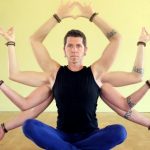 Creepy
Creepy  Creepy
Creepy  Movies and TV
Movies and TV 10 Movies That Get Elite Jobs Right, According to Experts
 Weird Stuff
Weird Stuff 10 Times Real Laws Were Based on Bizarre Hypotheticals
 Animals
Animals 10 Inspiring Tales of Horses Being Human
 Mysteries
Mysteries Top 10 Haunting Facts About the Ghost Ship MV Alta
 History
History 10 Surprising Stories About the Texas Rangers
 Humans
Humans 10 Philosophers Who Were Driven Mad by Their Own Theories
 Miscellaneous
Miscellaneous 10 Video-Game-Worthy Weapons and Armors from History
 Weird Stuff
Weird Stuff 10 Psychics Who Accurately Predicted Wartime Events
 The Arts
The Arts 10 Pieces of Art Inspired by a Broken Heart
 Creepy
Creepy 10 Death Superstitions That Will Give You the Creeps
 Movies and TV
Movies and TV 10 Movies That Get Elite Jobs Right, According to Experts
 Weird Stuff
Weird Stuff 10 Times Real Laws Were Based on Bizarre Hypotheticals
Who's Behind Listverse?

Jamie Frater
Head Editor
Jamie founded Listverse due to an insatiable desire to share fascinating, obscure, and bizarre facts. He has been a guest speaker on numerous national radio and television stations and is a five time published author.
More About Us Animals
Animals 10 Inspiring Tales of Horses Being Human
 Mysteries
Mysteries Top 10 Haunting Facts About the Ghost Ship MV Alta
 History
History 10 Surprising Stories About the Texas Rangers
 Humans
Humans 10 Philosophers Who Were Driven Mad by Their Own Theories
 Miscellaneous
Miscellaneous 10 Video-Game-Worthy Weapons and Armors from History
 Weird Stuff
Weird Stuff 10 Psychics Who Accurately Predicted Wartime Events
 The Arts
The Arts 10 Pieces of Art Inspired by a Broken Heart
The Ten Biggest Waves Ever Surfed
Big-wave surfing isn’t for everyone. In fact, it is not attractive for many keen surfers, who prefer waves no more than double-overhead in height. Mainly because after that, the fear far outweighs the fun.
After wiping out on a giant wave, many surfers feel like they are going to die, but remarkably few people die from surfing big waves. Buzzy Trent, a famous and uber-macho big wave surfer from the 1960s, was once quoted as saying, “Big waves are measured not in feet, but in increments of fear.”
So let’s get scared and take a look at the ten biggest surfed waves of all time, at least those that were documented.
Related: Top 10 Rarest Feats In Sports
10 Greg Noll: Makaha, Oahu, Hawaii, USA, 1969
No list of big-wave surfing exploits would be complete without the big-wave king of the 1960s, the legendary Greg Noll. Noll, who died in 2021, was a surfing icon, as much for his trademark black and white jailhouse-striped trunks and big personality as his massive appetite for big waves.
On the morning of December 4, 1969, during the famous “Swell of ’69,” Noll and a few others surfed the famous waves of Makaha Point on the west side of Oahu. Noll caught a wave that observers called the “Biggest Wave Ever” at some 12 meters (40 feet) plus.
Noll caught the wave, made it to the bottom, and wiped out, losing his board and barely making it to the beach alive. He quit surfing big waves on the spot, retiring to northern California to become a commercial fisherman and surfboard craftsman.[1]
9 Alec Cooke: Outside Pipeline, Oahu, Hawaii USA, 1985

In the 1970s and ’80s, the traditional pursuit of big-wave surfing was somewhat overshadowed by the newly formed professional tour, which was pulling in most of the money and attention in the surfing world.
One of the people who wanted to bring the spotlight back to big waves was local Alec “Ace Cool” Cooke, a dedicated big-wave rider and descendant of a wealthy and historic missionary family in Hawaii.
Cooke came up with a plan in 1985 to surf the biggest wave ever by being dropped from a helicopter with his board and an emergency oxygen tank into giant surf on the north shore of Oahu. He would be filmed and photographed for verification by a media crew in the helicopter, with the photos and film clips distributed worldwide.
The plan went reasonably well. Cooke caught a giant wave and was filmed riding it before he was caught by an even bigger wave, lost his board, and had to swim to the beach. Photos were published, resulting in a great deal of media coverage for Cooke. However, many surfers scoffed at the “Biggest Wave Ever” claim, saying the angle of the helicopter images had made the wave look bigger.
Cooke continued to ride big waves on the North Shore, paddling out at Waimea Bay on the evening of October 27, 2015, when he disappeared and was never seen again. Despite an extensive aerial search by the United States Coast Guard, no body was ever recovered.[1]
8 Brock Little: Waimea Bay, Oahu, Hawaii USA, 1990
A major factor in the revival of interest in big-wave surfing was the Quiksilver in Memory of Eddie Aikau event, held on the north shore of Oahu in Hawaii. Known as “The Eddie,” the contest was the centerpiece of a successful marketing campaign based on the life and legend of Hawaiian big-wave rider Eddie Aikau.
As “Eddie Would Go” only when the contest director determined the swell would be big enough for long enough to stage the entire eight-hour event, it was not held every year. By 1990, the marketing machine was in high gear, and when “The Eddie” was given the green light on January 21, expectations were as high as the waves.
Brock Little, a young and apparently fearless surfer from Hawaii, caught an enormous wave during the event—at 15 meters (50 feet)—which was photographed from multiple angles. Although he hit a bump and fell and did not complete the ride, it was widely acknowledged that Little had caught, stood up, and ridden the largest wave ever at the time.[3]
7 Ken Bradshaw: Outside Log Cabins, Hawaii USA, 1998
On January 28, 1998, the north shore of Oahu and the other islands in Hawaii were declared by local authorities to be under a “Code Red” event, when the surf is forecast to be so big that all state harbors and beaches are closed.
Just before the Code Red was declared and the harbors shut, a number of two-person teams on personal watercraft exited Haleiwa Harbor on the north shore of Oahu. The teams consisted of one surfer and one driver, with one person driving the PWC and towing the surfer at speed on a water ski rope to catch a giant wave. Tow-surfing is the preferred technique to catch and ride waves this big, as human arms and paddling are usually not fast enough.
One of the teams reached an outer reef spot called Outer Log Cabins, a wave in deep water that only breaks on the biggest of winter swells. This morning, the waves were estimated at 15 to 18 meters (50 to 60 feet). As crowds watched from the beach with binoculars and telephoto lenses, surfer Ken Bradshaw was towed into a monster wave by driver Dan Moore and successfully rode what was photographed as an 18-meter (60-foot) wave, the biggest ever ridden at the time.[4]
6 Mike Parsons: Cortes Bank, California, USA, 2008
It was in the late 1980s that legendary Surfing Magazine photo editor Larry “Flame” Moore started to look into the location and bathymetry of Cortes Bank, about 160 kilometers (100 miles) off the coast of southern California. Moore had seen a newspaper article about the USS Enterprise aircraft carrier hitting a submerged seamount. If a reef out there was shallow enough to damage a ship, then could there be waves breaking on the right swell and conditions?
By 1990 the answer was “probably,” so Moore chartered a plane and, on a big swell with light winds, flew out to Cortes Bank and photographed one of the wonders of the surfing world. For the first time, he captured images of giant, perfectly rideable waves as they broke over the bank in the middle of the Pacific Ocean.
By 2001, several expeditions had been made to Cortes Bank by boat, and giant waves had been ridden and documented. In 2008, a massive winter swell was generated in the north Pacific ocean, with a corresponding light local wind forecast at Cortes Bank.
Mike Parsons, a California professional surfer, made the trip by boat with a group of fellow big-wave surfers and caught the biggest wave ever ridden at the time, estimated at 23 meters plus (75 feet), riding it into the safety of the deeper water next to the seamount.[5]
5 Garrett McNamara: Nazaré, Portugal, 2011
In 2005, a local surfer from Portugal had invited Hawaii big-wave surfer Garrett McNamara to Nazaré, as he said there were giant waves breaking in front of the lighthouse in winter with no one surfing.
McNamara was from Hawaii and had the attitude that Hawaii has the biggest and best waves in the world, so he brushed off the suggestion that there were bigger waves breaking in the Atlantic ocean, not the Pacific.
It took Garrett five years and a pile of photo evidence to get around to going to Nazaré in winter to try to surf these giant waves, but when he finally did in 2010, he was impressed. The following winter season in 2011, McNamara earned a certified Guinness World Record for the biggest wave ever surfed at 23.7 meters (78 feet), the biggest wave ever ridden at the time.
McNamara now lives in Portugal and his big wave quest is featured in the documentary television series “100 Foot Wave.”[6]
4 Ramón Navarro: Cloudbreak, Fiji, 2012
Chilean surfer Ramón Navarro received an “Adventurer of the Year” award from National Geographic in 2013 for his enormous wave caught in Fiji in June the year before, a huge blue tube breaking over a coral reef miles out to sea in the south Pacific Ocean.
Navarro had flown from Chile to Fiji on the news of a rare forecast in which several powerful low-pressure systems had improbably lined up below Australia in the raging Southern Ocean. These weather systems would combine to produce a colossal groundswell that would travel to the northeast, through the Tasman Sea, and straight toward the coral reefs of Fiji, thousands of miles away.
While the reef at Cloudbreak in Fiji has been surfed consistently since the 1970s, no one had seen waves this big in living memory. Navarro was towed into the wave by his partner Kohl Christensen on a PWC and successfully rode the massive 18-meter (60-foot) blue cylinder into the deep water of the channel next to the coral reef.[7]
3 Jamie Mitchell: Belharra, France, 2014
The Bay of Biscay lies below the United Kingdom in the North Atlantic and has a deserved reputation as one of the world’s stormiest seas, especially in winter. The large bay is also open to the North Atlantic, receiving large groundswells from storms originating near Greenland in the winter months.
In January 2014, there was an exceptionally large and ferocious North Atlantic winter storm named Hercules. Storm Hercules would generate an improbably large groundswell, with the absorbed energy of wind on water pointed directly at a reef off the southern coast of France in the Bay of Biscay called Belharra.
The deep water reef at Belharra only breaks on the biggest swells, perhaps two or three times in a winter season. A small group of big-wave surfers was there to meet the swell from Hercules on January 7. Among them was Jamie Mitchell, an outstanding ocean athlete and surfer from Australia who paddled into and caught a 20-meter (65-foot) wave. Mitchell wiped out but survived and earned his “Wipeout of the Year” nomination for 2014 for one of the biggest waves ever surfed.[8]
2 Mark Healy: Puerto Escondido, Mexico, 2015
The Mexican Pipeline at Zicatela Beach in Puerto Escondido in Oaxaca state in the steamy tropical regions of southern Mexico has been well-known among surfers for large, powerful waves for decades.
Zicatela Beach faces directly southwest, where it can receive powerful groundswell from winter storms in the south Pacific Ocean from April to October. In May 2015, an exceptionally large swell was forecast for mainland Mexico, and big-wave rider Mark Healy was in position to take advantage of the swell to try and ride some very large waves.
Healy paddled out on a 3-meter (10-foot) board from the protected harbor and then down the coast to Zicatela Beach. There, where massive waves were breaking, much further out than usual, including some of the biggest waves veteran surfers had ever seen at this beach. The surge from the swells flooded streets in town with salt water, and several homes and businesses were swamped.
Healy chose his wave carefully and paddled hard. With no PWC to tow him into the wave, he had to generate enough speed with just his arms to catch the swell as it began to break. He caught the wave and stood up, and as the wave moved closer to shore, felt the sand bottom and began to break—it exceeded 15 meters (50 feet) in height.
Healy kept riding until the wave closed on him, getting washed into the beach still alive from the flotation aid of his inflatable vest. Healy had easily ridden the biggest wave ever paddled into at Playa Zicatela and perhaps the largest wave ever caught anywhere without a PWC tow-in assist.[9]
1 Sebastian Steudtner: Nazaré, Portugal, 2020
The unique bathymetry at Nazaré is what makes the enormous waves possible: the combination of powerful, long-period groundswells and a deep-water offshore canyon producing refractions that amplifies the incoming swell energy into massive peaks.
At Nazaré, the constructive interference is so extreme that the stated deep-water swell height in a forecast can be doubled or even tripled by the canyon refraction effect, producing enormous peaks in front of the lighthouse at the now-famous Praia do Norte, or North Beach.
On a large winter swell 0n October 29, 2020, Austrian surfer Sebastian Steudtner, a windsurfing convert to big-wave surfing, was towed by his PWC driver into one of these majestic peaks and went screaming down the face of the wave, eventually reaching safety on the shoulder.
He did not know it at the time, but the wave was later scientifically calibrated at 26 meters (86 feet), thus earning Steudtner a new certified Guinness World Record for his efforts, a record that took experts 18 months to confirm as the largest wave ever surfed.[10]








